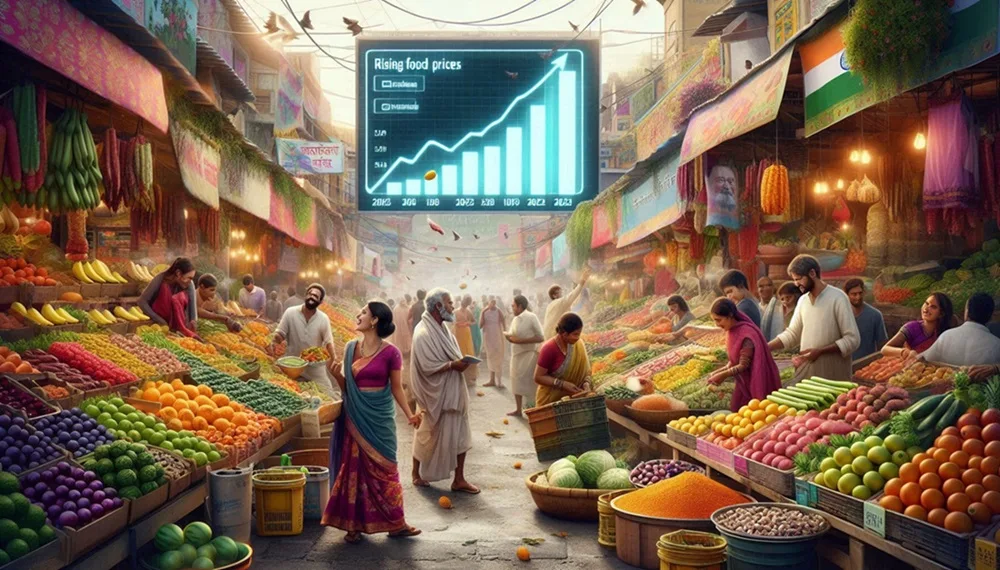🧩Why Your Grocery Bills Feel Heavier in 2025 If your monthly grocery expenses feel like they're quietly sneaking higher each month—yo...
🧩Why Your Grocery Bills Feel Heavier in 2025
If your monthly grocery expenses feel like they're quietly sneaking higher each month—you’re not imagining it. India is witnessing one of the steepest rises in food inflation in recent years. But how bad is it really? Let’s dig into the data behind your plate—from soaring vegetable prices to the cost of cooking oil and cereals.
 |
| Effects of rising food prices on economy India index |
📈 Inflation and Rising Food Prices in India – What the Data Says
India's food prices are soaring — and millions are feeling the pinch. In March 2025, retail inflation in food crossed 9.5%, putting extra burden on households already battling economic uncertainties. But what’s truly driving this rise?
🍚 The Pulse of Inflation: Monthly Trends – What the Official Data Says
According to the Ministry of Statistics and Programme Implementation (MoSPI), India's Consumer Food Price Index (CFPI) for February 2025 rose to 8.1%, compared to 6.2% in January 2025 and 5.9% in December 2024. This steep increase is largely driven by vegetables, pulses, and cereals. Here’s a look at the monthly food inflation trends over the past year:
 |
| 📈Monthly Food Inflation in India (Oct 2024 - Feb 2025) |
📊 Which Items Are Getting Costlier?
Data shows vegetables, cereals, and pulses saw the steepest price hikes. Let’s break it down by food categories. Here's the price rise compared to the same period last year:
- Vegetables: +14.3%
- Pulses: +12.8%
- Cereals: +11.2%
- Milk & Dairy: +8.6%
 |
| 📊Price Rise by Food Category (YoY %) |
🧅 Vegetables like onions and tomatoes have seen the highest jump, mainly due to unseasonal rainfall and supply chain disruptions.
🍚 Cereals and pulses are also up due to lower harvest and export curbs.
🧼 Milk and oils continue a steady climb due to increasing transportation and production costs.
How Does India Compare Globally?
Globally, food inflation has stabilized in many countries. According to the FAO Food Price Index, international food prices have dropped by 5.6% year-on-year in Q1 2025.
In contrast, India is still facing high domestic inflation, mainly due to:
- Climate-related issues (rains and droughts)
- Export bans and price controls
- Increased transport fuel costs
🛢️ For example, diesel prices are up by 9% YoY, impacting logistics.
What the Data Tells Us
- Rural India is more affected, as food comprises 50-60% of household consumption.
- Middle-class households in urban cities are feeling the pinch in milk, oil, and rice.
- Government subsidies (like for pulses) are helping but not enough to curb the impact.
👀 Analysts predict that unless Kharif crop output improves by mid-2025, the pressure will continue through the year.
🌦️ Weather Woes + Global Factors
Erratic rainfall has impacted food production across major states. Maharashtra, for example, saw a 15% drop in onion yield. Globally, reduced rice exports from Southeast Asia and the ongoing effects of the Ukraine conflict are also pushing up prices.
💰 Impact on the Common Man
A simple thali that cost ₹30 in early 2023 now costs around ₹38-₹42. For a family of four, that adds up to over ₹1,200 more per month in food expenses.
As someone managing household budgets and groceries in urban India, I’ve personally noticed a sharp uptick in the price of daily essentials. What cost ₹1000 a year ago now easily crosses ₹1300, especially for vegetables, dairy, and basic cereals. This blog post combines both personal observations and national data trends to give a clearer picture of what’s really happening.
 |
| 🥧Share of Household Spending on Food (Urban vs Rural) |
A Data Story That Hits Home
📚 Data Sources
- Ministry of Statistics and Programme Implementation (MoSPI)
- FAO Food Price Index – UN Food and Agriculture Organization
- Trading Economics – India Food Inflation
- Reserve Bank of India Reports
📌 Final Thoughts
Data reveals not just that prices are rising—but why. From rainfall to global exports, the food on our plates is being shaped by complex trends. Understanding these numbers is the first step in managing their impact.
If you’re fascinated by insights like these and want to explore the world of data analysis, our courses can help you learn how to turn raw data into meaningful insights. Whether it's SQL, Tableau, or Excel, data analysis skills can reveal the hidden stories behind numbers, just like the ones we’ve covered here. Enroll now and start your journey!
🎓 Learn SQL for Data Analysis in Layman Terms for Non-Techies – Enroll Free
👨💻 About the Author
Prem V is an Assistant Manager in Digital Analytics at Big 4 firm and the founder of Layman Data Academy. With over 13 years of experience in business intelligence and data analytics and insights, he simplifies complex data concepts for non-tech learners. Prem teaches SQL, Tableau, and data visualization through practical, real-world examples. He has also completed a Data-Driven Decision Making course from the University at Buffalo via Coursera.







No comments